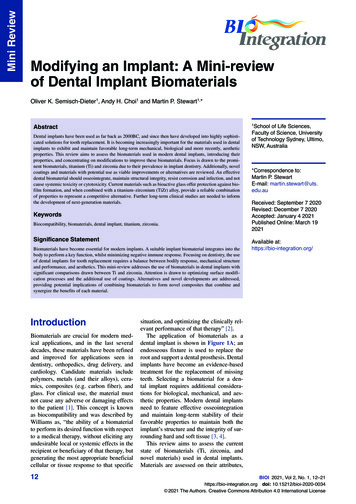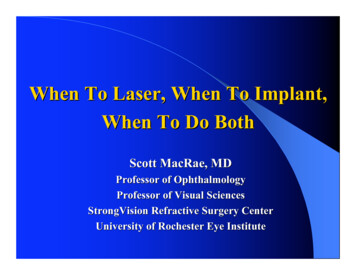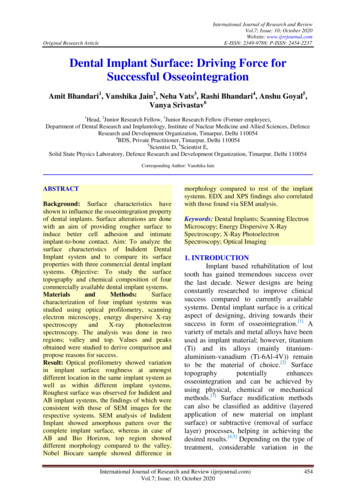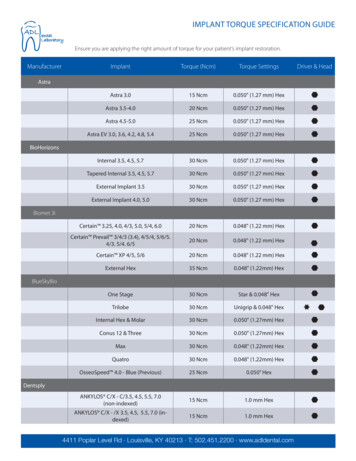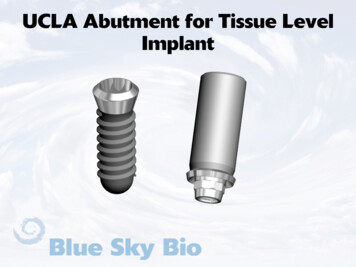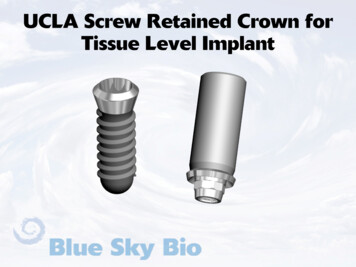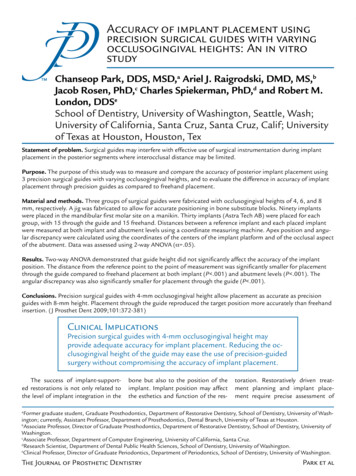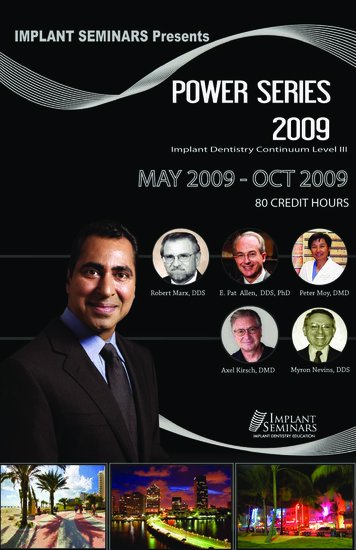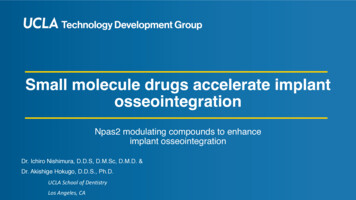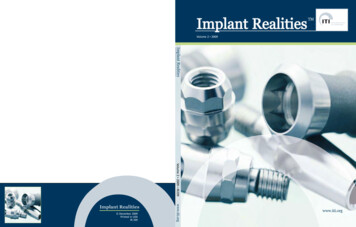
Transcription
Implant RealitiesTMVolume 2 2009Implant RealitiesVolume 2 2009 IR209 December 2009Printed in USAIR 209www.iti.orgImplant Realitieswww.iti.org
ITI Mission Statement:To promote and disseminate knowledge on all aspects of implant dentistry and dental tissueregeneration through research, development, and education to the benefit of the patient.Implant Realities, Volume 2, 2009PublisherPublisherInternational Team for ImplantologyImplant Realities is published biannually by the International Team for ImplantologyUS Section(ITI) US Section 2009. All rights reserved. No parts of this journal may beEditorial BoardPaul A. Fugazzotto, DDSprogressiveperio@aol.comFrank L. Higginbottom, DDSbottom@dallasesthetics.comreproduced without permission from the publisher. The opinions expressed inarticles are those of the authors and not necessarily those of the publisher or theeditors.A free copy of Implant Realities is sent to each US section ITI member and fellowat the time of its publication. Additional copies are available at a cost of 12.95Graphic Designper copy. Contributing authors receive ten free copies of the issue of ImplantStraumann USA, LLCRealities in which their article appears.PrintingDS Graphics, Inc. – Lowell, MA
Welcome to Implant Realities TMWelcome to the “Congress Issue” of Implant Realities. As you know, the US ITICongress was held on April 24th and 25th in Scottsdale, Arizona. Over 600 attendeesparticipated, listening to numerous expert presentations and trading ideas with theircolleagues.As always, both the presentations and discussions among Congress attendees duringthe breaks were characterized by a desire to deliver reality based comprehensive careto patients.Paul A. Fugazzotto, DDSThis issue of Implant Realities begins with editorials from ITI Fellows from variousEditor in Chief,branches of dentistry, in an effort to underscore the importance of comprehensiveImplant Realitiesinterdisciplinary therapy.Many of the presenters from the US ITI Congress were generous enough to sharesynopses of their presentations with us, as you will see in the ensuing pages.Sharing of knowledge and a concern for delivery of the most up to date care possiblein order to address patient needs and desires, based upon unassailable research andmeticulous clinical execution, are the hallmarks of the ITI.Sincerely,Paul A. Fugazzotto, DDSEditor in Chief, Implant RealitiesVolume 2 20091
Table of ContentsMeet the ITI:ITI Fellow: Robert A. Levine, DDS4ITI Member: Harry Randel, DMD6Editorials:The Role of Oral and Maxillofacial Surgeons in Implant Dentistry8John-Michael Stewart, DMDThe Importance of the Restorative Dentist in Delivering Comprehensive Patient Care9Robert C. Vogel, DDSThe Role of the Periodontist in the Field of Dental Implants10Jay R. Beagle, DDS, MSDWhy A Laboratory Technician is Important in Comprehensive Treatments11Jeff SinglerThe Importance of the Orthodontist in Delivering Comprehensive Care12Frank Celenza, DDSSurgical:Beyond Titanium; Where No Implant Has Gone Before!14David L. Cochran, DDS, PhDTissue Level Versus Bone Level; Is There a Difference?16Jay R. Beagle, DDS, MSDThe Replacement of Hopeless Teeth in the Esthetic Zone with Dental Implants – A Decision-Making Dilemma18Farhad E. Boltchi, DMD, MSComputer-Guided Implant Placement; Planning Software, Fixed Intra-oral Reference Points and CAD/CAM Technology22Dr. Ali TahmasebClinical Review of Minimally Invasive Extraction Techniques26Eduardo R. Lorenzana, DDS, MSGuided Wound Healing – Trans-mucosal Development in the Esthetic Zone30Steven I. Present, DMDThe Use of Shorter Implants in Clinical PracticePaul A. Fugazzotto, DDS2Implant Realities36
Restorative:A Simplified Procedure to Ensure Optimal Gingival Contours for the Single Implant-Supported Crown in the Esthetic Zone44Richard P. Kinsel, DDSIndications, Planning and Restorative Techniques Utilizing the Bone Level Implant –Preliminary Results from a Multi-Center Clinical Trial48Will Martin, DMD, MSRestoration of Immediately Placed Implants in 3 Appointments From Surgical Placement to Definitive Prostheses52Carlo Ercoli, DDSFrom Casting to CADCAM: Technology Affecting Clinicians Today56Brody J. Hildebrand, DDS, MSTeam Dentistry: Optimizing SLActive Surface Technology to Reduce Treatment Time, Maximize Predictabilityand Increase Patient Satisfaction62Robert A. Levine, DDSThe Interdisciplinary Treatment of Patients with Hypodontia and Oligodontial68Nadine Brodala, DDS, MSLoading Protocols for Completely and Partially Edentulous Patients72Dean Morton, BDS, MSAchieving Maximum Esthetic Results through Proper Laboratory Communication76Vincent W. Meng, DDS, PCVolume 2 20093
Robert A. Levine, DDS maintains a full time practice in Northeast Philadelphia focusing on Surgical ImplantMeet the ITIPlacement, Cosmetic Oral Plastic Surgery Procedures, Regenerative Therapy, Adult Orthodontics and Oral Medicine. Heis Chairman Emeritus of Periodontics at Albert Einstein Medical Center (1984-2003) and presently is Clinical AssociateProfessor of Periodontics in the Post-Graduate Department of Periodontics, Periodontal Prosthesis and Implantology at theUniversity of Pennsylvania School of Dental Medicine. Dr. Levine is a Fellow of the International Team for Implantology(ITI) and a Fellow of the College of Physicians in Philadelphia, PA. He is a visiting lecturer at Temple University, New YorkUniversity, Nova Southeastern University and University of North Carolina Schools of Dentistry. Dr. Levine is a Diplomateof the American Board of Periodontology and serves on the Editorial Boards of five international scientific journals.Why did you join the ITI?My history with the ITI goes back to1990 when Max Listgarten, one of mymentors/professors at the University ofPennsylvania who had spent a year inSwitzerland doing research, invited meto hear about a Swiss implant system. Iwas not familiar with the 2 presenters atthe time. However, I was truly impressedwith the results they presented.Danny Buser and HP Weber discussedsurgical and restorative perspectivesand demonstrated impressive results,with both the mandible and maxillaebeing nearly equal in success. Since1986, I was having the experience ofBranemark failures in soft bone (Type4) in the posterior maxilla, as reportedby Jaffin and Berman. When Drs. Buserand Weber presented the results of theirearly studies on the TPS surface and thesystem’s simplicity, I was “converted”.Literature ReviewTeam DentistryRestorativeSurgicalEditorialsMeet the ITI Fellow: Robert A. Levine, DDS4Why do you think Fellowship is important?For two primary reasons. I am able toraise my level of clinical practice throughmy interactions with others around thecountry and world-wide, as we shareclinical techniques to improve ourpatients outcomes. I strongly believethat the best professional decision I havemade was getting involved and stayinginvolved with the ITI. The second reasonis the camaraderie . Life-long friendshipshave developed amongst the Fellows andMembers. It continues as we enlarge theUS ITI Section. We enjoy seeing eachother at each of the Fellows businessmeeting and US and World Symposiums.The integrity of the Fellows, with a strongdesire for seeing “the Evidence,” is animportant aspect of what we all strivefor, unlike most implant companies. TheITI is truly unique in its philosophy andmessage in dentistry.I started placing Straumann implants inearly 1991. They have been my implant ofchoice since then. From a periodontist’sstandpoint, I was also impressed withDanny’s discussion of incision design, theincredible soft tissue healing of tissuelevel implants and the importance ofmaintaining keratinized gingiva. Herewas an oral surgeon who spoke like aperiodontist! While Branemark singletooth studies in the 1990s reported asignificant problem with screw-loosening,our experience was quite the contrary.What do you see as the value of the US ITI?During my first visit in 1993 to anITI World Symposium, in Basel, I wasintroduced to Frank Higgginbottom,Tom Wilson and others. As a result ofour discussions regarding the Staumannimplant, morse taper and lack ofprosthetic problems, along with similarsuccess rates to those of the Swiss, weco-authored a series of retrospectivestudies on Straumann single toothimplants in posterior applications(JOMI 1997,1999,2002,2007) with otherclinicians around the country. Thisexperience got me involved early in mycareer and has made an impact since then.How has the US ITI helped you?Implant RealitiesHands down the quality of the peopleinvolved and the educational programsthat are part of The US ITI and WorldSymposiums. The ability to continue tostay ahead of the curve with a strongfoundation based upon the literaturefurthering my personal ambition to bethe best I can be for my patients and formyself. The “bar” continues to be raisedthrough what I learn from my colleaguesand friends.My desire to run clinical in-office studieswith fellow clinicians from the mid-1990s,which continues today with ITI Fellowsand Members who strive for qualityclinical publications, could not havehappened without my involvement inthe US ITI. In addition, my involvementproduced our Philadelphia-based localITI-funded (from ITI Central: Basel,Switzerland) Study Club, which I co-directwith Joe Fiorellini. In conjunction withthe Philadelphia Dental Implant andPerio-Prosthesis Study Cub, which I havedirected for over 25 years, the ITI hascontributed to my continuing educationprofessionally. Many of the guest speakersare friends from the ITI who I have hadprofessional relationships with for manyyears, and who deliver similar messagesthrough the sharing of knowledge towith Philadelphia area colleagues. I amproud of the fact that the ITI, a non-profitorganization, is on the fore-front of dentalimplant and regenerative research, withthe most funding for this type of researchworld-wide.What has the ITI done well?Being literature/evidenced-based is myfirst thought of what the ITI has donewell. This goes hand-in-hand with theConsensus Conferences, which havebeen held world-wide every 5 years since1993. My involvement in the August2008 Consensus Conference in Stuttgart,Germany was a personal highlight of myprofessional career. It was an incredibleexperience, with representation fromclose to 30 countries and 99 participants.The state of the art position papers inimplant dentistry from this conferencewill be published in a special issue ofIJOMI. This alone separates the ITI formall other players in the field of implantdentistry. In addition, the quality ofthe programs put on locally, nationallyand world-wide is fantastic. Stressingproper education, and not going directto generalist dentists to teach themsurgical placement without propertraining, is ethical and important. Toomany companies lack integrity, in myopinion, as they “certify” dentists as readyto be implant surgeons after a week-endcourse. This in not in the best interestof the patient. It is in the best interestof the company’s bottom line. Lastly, thequality of the US ITI publication, ImplantRealities, is something, as an ITI Fellow,I am very proud of.
Would you like to add anything else?I would like to reiterate that gettinginvolved in the US Section of the ITI,if you have not done so, should be onyour agenda for 2009-2010. If you haveany questions you can contact me atRLEVINE@PADENTALIMPLANTS.COM.Thank you Paul for allowing me to sharemy views on the ITI. keep up the greatwork at Implant Realities!EditorialsI would like to see more web-basededucation programs, which we on theeducation committee are starting todevelop. Our first program will featureProfessor Dean Morton, formerly ofUniversity of Florida at Gainesville, andpresently at University of Kentucky atLouisville, on prosthetic managementof dental implants. In addition, reachingout more to younger clinicians andgraduate students to become involved isimportant, as evidenced-based implanttherapy should go hand-in-hand withtheir educational goals as post-doctoralstudents. Sponsoring regional meetingswill also help to ensure participation ofmore members and sharing of knowledge.Meet the ITIWhat will you like to see the US ITI do?What do you see as the greatestchallenges facing dentistry?SurgicalI see the greatest challenges, besidesthe cyclical economy, as the “drivingof the market” by companies andcorporations without adequate research.Dental implant companies are a primeexample. I was shocked recently when Iread that there are close to 150 implantcompanies world-wide. Only a few, withStraumann in the fore-front, are spendingprofits in developing better products forour patients. Too few companies spendmoney on research. This will only giveimplant therapy a bad name, as manypatients have already suffered becauseof this lack of R&D over the years. Manycompanies come and go. You do notwant to be stuck when your companygoes bankrupt, and a solution for asurgical or prosthetic problem cannot befound because the company no longerexists. This has to be mind-boggling forrecent dental school graduates. Moststudents are not taught how to look atthe literature critically, to establish aliterature-based decision. They are toofrequently led by the opinions of dentalcompany representatives. My motto is“show me the studies”.RestorativeTeam DentistryWhat do you see as the greatestchallenges facing you in dentistry?Volume 2 20095Literature ReviewWith the explosion in the fields ofregeneration (GTR/GBR), esthetics andimplant dentistry, my greatest challengeis keeping up. Thus, I continue to attendmany CE courses and continue to teachon a post-graduate level at a number ofuniversities. Teaching keeps me current.Being an ITI Fellow/Member helps in thisprocess tremendously, as the ITI is in thelead with what I do on a daily basis inclinical practice.
Harry Randel, DMD received his DMD from the University of Pennsylvania School of Dental Medicine in 1983,Meet the ITIcompleted a general practice residency at the Veterans Administration Medical Center in 1984, and earned a certificate inProsthodontics at the Temple University School of Dentistry in 1986. Dr. Randel currently owns a private practice in Blue Bell,Pennsylvania, and has over 25 years of experience as a practicing prosthodontist and advanced restorative dentist. Dr. Randelremains committed to offering his patients the best possible care, and is an active member in many professional organizations,including the American Dental Association (ADA), the Pennsylvania Dental Association, the American College of Prothodontists,the Northeast Dental Implant Study Club, the Eastern Dental Society, the Academy of Osseointegration, and the InternationalTeam for Implantology. Additionally, he has published articles in various peer-reviewed publications, such as “Treatment andManagement of Dentoalveolar Abscesses,” Liberty Bell Conference March 1984; “Rotary Reduction, Enamel Microabrasion, andDental Bleaching for Tooth Color Improvement” Compendium of Continuing Education in Dentistry, January 1998; “SolvingCosmetic Dilemmas in the Esthetic Zone” Contemporary Esthetics and Restorative Practice, June 2001.I was introduced to Straumann implantsseveral years ago through my closeassociation with Dr. Robert Levineand the Philadelphia Dental ImplantPeriodontal-Prosthesis Study Club. Therewere many informative and excellentlectures presented by the ITI. I saw thevalue the ITI offered Dr. Levine and hiscareer. I have utilized the Straumannimplants since the early 1990’s. Havingcompleted courses in many otherimplant systems, I felt that Straumannimplants offered me the ability to beon the cutting edge of implantology.The network of worldwide cliniciansand educators could afford me the mostup to date research and information,provided in a practical way for theclinician. Their passion for what theydo and how strongly they believe in theorganization impressed me. I attendedseveral symposia and felt the comradery,so I decided to become a member. I haveapplied and have been nominated forfellowship. I look forward to that nextstep in my affiliation.RestorativeWhy do you think Membership is important?Team DentistryMembership in the ITI is importantbecause it supports the organization andthe development of new ideas. It is thestrength of the network of Members thatallows the exchange of ideas and helpsmake this organization extremely patientoriented, and supportive for the clinician.The Members I have had the opportunityto converse with and learn from haveimpressed me. I feel that I am always ableto find someone who is willing to discussany questions I have! This is an extremelyimportant and a valuable benefit ofmembership.What do you see as the value of US ITI?Literature ReviewWhat would you like to see the US ITI do?Why did you join the US ITI?SurgicalEditorialsMeet the ITI Member: Harry Randel, DMDThe international constituency isextremely strong. It is important that theUnited States be represented, so thattrends in the United States are recognizedand supported by the internationalumbrella. The US ITI allows me to stay6Implant Realitiesinvolved locally with the cutting edgeresearch and education that the ITI offers.I am always on the internet and wouldlike to see some more web basedprograms and information.How has the US ITI helped you?It has helped me grow as a prosthodontistby providing me with the most up to dateresearch, education and developments inthe field of implantology. I work extremelyclosely with the periodontist and oralsurgeon to make sure that the implant/implants placed are ideal for the patient.I integrate all the knowledge I haveobtained to provide the patient with thebest treatment possible. I feel that theinformation I have gleamed from the ITIhas helped to put me in the forefront ofmy field through the lectures, researchand articles and the interpersonalrelationships I have established. Theteam approach is the way I love topractice dentistry. I believe those whoare “Jacks of all trades, are “masters ofnone." Straumann and the ITI fosterthe team approach, thereby giving ourpatients the advantage of the expertiseof all of the specialties: periodontics, oralsurgery, orthodontics, endodontics andprosthodontics. Additionally, I find thatwhen I attend the meetings the fellowattendees are clinicians and researcherswith whom I can discuss my mostadvanced and challenging cases. Theseinteractions have enhanced my abilityto grow as a Prothodontist and treatmy patients with the quality care andattention I value.What has ITI done well?The information, research, educationand level of concern and care that theITI provides for the betterment of thefield of implantlogy is what I value. Theyprovide quality symposia with interestingand informative presentations. The ITI isextremely professional and fosters bothwonderful professional relationshipsand an opportunity for self growth.The ITI helps to raise the level of myown practice. I always look forward toattending the meetings.What do you see as the greatest challengesfacing dentistry?With economic concerns, patients needto understand the value of the advanceddentistry we are able to offer. Getting theword out that implants provide a wayto predictably replace teeth is key. Onceimplants become the standard of care, wecan overcome the financial challenges,because patients will understand thevalue of implantology.Not only are implants the best way toreplace missing teeth, they also areappropriate for teeth with questionableprognoses, including those that requireseveral procedures, such as endodontics,crown lengthening, post core and crown.I hope that we can get the word out thatimplants are the standard of care, not anupscale alternative.What do you see as the greatestchallenges facing you in dentistry?There is so much new information andresearch every day. I value the attentionand up to date treatment that I am ableto offer my patients. So, it is importantthat I am able to learn and implementthis in
Brody J. Hildebrand, DDS, MS Team Dentistry: Optimizing SLActive Surface Technology to Reduce Treatment Time, Maximize Predictability and Increase Patient Satisfaction 62 Robert A. Levine, DDS The Interdisciplinary Treatment of Patients with Hypodontia and
